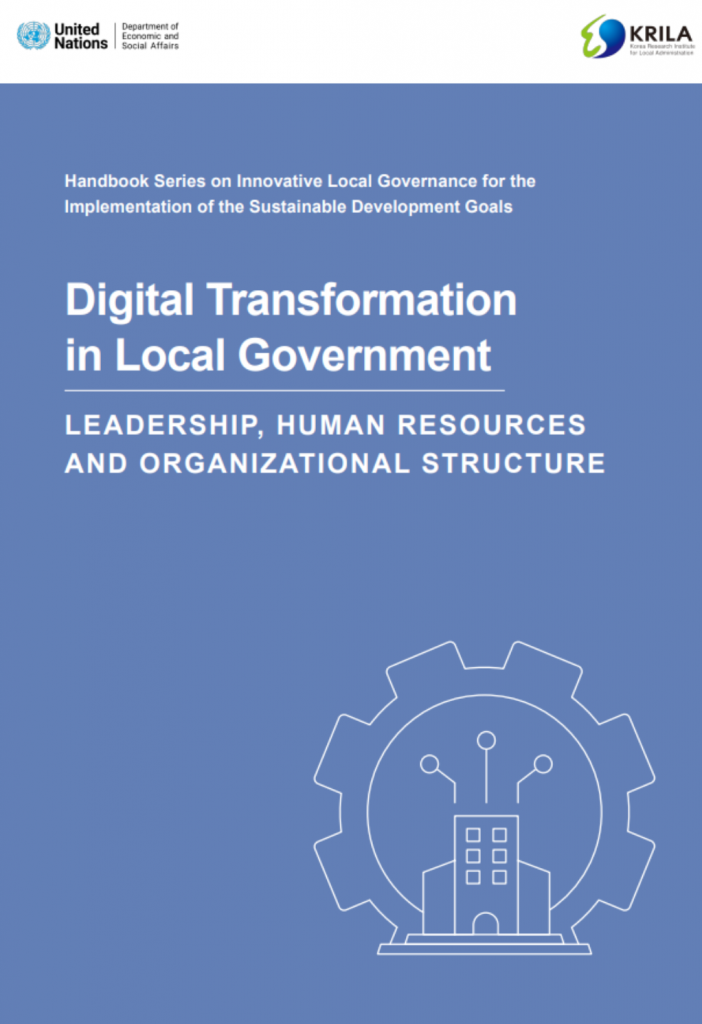The age of digital transformation, including the evolution of early e-government efforts towards a more holistic and user-centered approach, has arrived. The 2030 Agenda for Sustainable Development (2030 Agenda) includes a focus on governments’ digital transformation potential to achieve the Sustainable Development Goals (SDGs). To date, governments’ input and resources for digital transformation have mainly been in the introduction of specific technologies. The changes remain mainly at the level of the central government. As a result, it is difficult to find a clear consensus on the concept, goals and strategies of digital transformation at the local level. Discussions on digital transformation in local governments have been neglected. This handbook introduces the concept of digital transformation to policymakers and public managers who are contemplating the digital transformation of local governments. It introduces various organizational management elements required for successful digital transformation, including the leadership, human resources and organizational structure of the digital innovator which are said to be the most essential elements for digital transformation. Examples of successful efforts from several countries also are included.
This handbook consists of five chapters, each addressing a thematic concept.
Chapter 1 introduces the concept of the digital transformation of local government. Existing literature on the topic does not produce a clear consensus on the concept, strategies to achieve it, or objectives to be accomplished through it. A comprehensive approach needs to be built that connects people with new values, strategies and processes and goes beyond a methodological approach limited to digital technology. A comprehensive approach to digital transformation in local government means including new ways of transforming organizational processes and culture based on digital technologies and data, collaborating with stakeholders around public value, building new frameworks for public service delivery, and establishing new types of relationships between citizens and local government.
Chapter 2 looks at studies to date on local government innovation. Factors known to influence local government innovation are expected to have a strong impact on local government digital transformation. They can be divided into internal characteristic factors (those related to human resources within an organization, organizational structure and various material resources influencing local government innovation) and external environmental factors (such as stakeholder-related factors, legal and institutional factors and governance factors). Chapter 2 discusses strategies for the digital transformation of local governments, focusing on leadership, human resources and organizational structure, based on the principle that a sophisticated organizational strategy is required to build a digital local government.
Chapter 3 introduces digital leadership. Digital leaders play an important role in each stage of planning, execution, evaluation and follow-up of digital transformation. In the digital transformation planning stage, vision and goal setting, readiness evaluation and resource allocation and management should be performed. In the execution stage, monitoring and planning optimization, organizational process optimization and motivation for members are required. In the evaluation and follow-up management stages, the continuous cycle of digital transformation needs to be structured and mid-to-long-term plans for digital transformation optimized. Digital leaders must perform complex functions. This chapter addresses C-suite positions similar to those in the private sector that may support local government digital transformations. It also addresses why continuous and systematic education and training are essential to develop and build the technical and business capabilities of digital leaders.
Chapter 4 addresses human resource acquisition for digital transformation. Many local governments do not have enough manpower equipped with digital literacy to meet demands and do not have the resources to strengthen their digital capabilities. There are two main ways that local governments can secure human resources for digital transformation. First, training and education programmes related to digital innovation technology can be provided for civil servants. Those programmes should include both current and future skills needed. Incentives for participation in education and training should be considered. Training should be structured so that best practices are shared, and the latest technologies can be acquired through external networking. The second way to secure human resources for digital transformation is to recruit external experts into the government, offering them monetary and non-monetary incentives taking into consideration the national context. This should be strategized in cooperation with the central government and all local governments, not at the level of individual local authorities.
Chapter 5 introduces the organizational structure for digital transformation. Currently, digital innovation-related work in many local governments functionally separates into planning and coordination and execution and management, taking a decentralized structure in which policy functions are distributed in different departments for each sub-area of digital innovation. For digital transformation to succeed, local governments with such a decentralized structure need to redesign themselves into organizations with a centralized structure.





